June 2, 2005
Diving by the volcano. Thursday, June 2nd, 2005
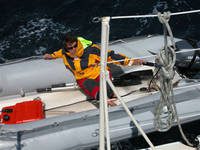
Nearly Fifty miles from the islands of Pico and San Jorge is the location of the Joao de Castro ridge, an underwater active volcano standing at 1,000 meters from the bottom and whose summit is just 13 meters from the surface of the sea. The sight around them is impressive, because of the methane gas emissions in the form of sumbarine fumaroles we can see and in general the hydrothermal activity observed around is worth seeing. There are also very interesting ecosystems emerged in the area: it is an illuminated oasis at surface level, in the midst of a dark world at the heart of the Atlantic.
The visit to the surrounding area of Azores was planned since before our ship arrived in the archipelago, but our interest grew as we read scientific works on this underwater volcano and as we exchanged ideas with researchers from the Department of Oceanography and Fishing from the University of Azores.
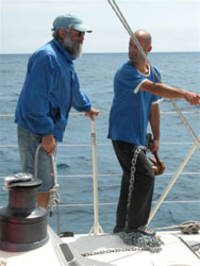
Dives from the previous days took place at the Island of Faial-where the Ranger was docked-and were done under very harsh conditions. The sea was agitated, visibility was frankly poor and the water temperature did not exceed 16 degrees (celcius). Although the equipment used by Oceana divers was very well maintained to ensure quality and safety standards, the truth is we had not considered at the moment using what is known as “dry diving suits”. This type of equipment is very expensive, and is used for diving at very low temperatures, contrary to wet diving suits, which lets water circulate on the inside of the suit. We use the latter type while on board the Ranger. As a matter of fact, most dives to take place in this expedition were planned for temperate, tropical areas such as the Mediterranean in summer months. However, Bermudas and the Azores have been the exception.
So Mar Mas was fitted with a semi dry diving suit she had brought along and Soledad Esnaola wore two layers of wet diving suits. In those conditions, they faced three daily dives, each lasting forty minutes and under close watch by Bibi Alvarez, who remained sitting on the auxiliary boat. Bibi was “promoted” to the rank of first officer of the Ranger, after Carlos Perez departed Azores to return to Spain, in order to prepare new activities for the ship upon arrival in the Mediterranean.
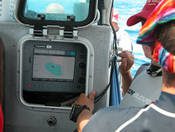

New difficulties were added to those mentioned above. Our divers had intended to explore underwater caves located near Horta, but they were kept from doing it by groups of thousands of Portuguese man-of-war (Physalia physalis ). These animals gathered in the inlet area of the island, carried by the action of the existing wind and tide. The dangerous nature of these animals-related to jelly fish-, whose bite can cause dangerous reactions in a person and even death in a few cases, made us reconsider our original plan. Therefore, we moved the dive to an underwater mound between the islands of Faisal and Pico. However, once inside the water, the divers realized that strong underwater currents and poor visibility made it practically impossible to proceed. That is why we had to settle for carrying out dives in less interesting areas, where we were able to film and photograph all forms of fish, equinoderms, and nudibranch species. Analysis of these images is still pending.
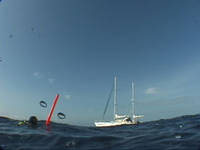 As we left Horta on Wednesday, we did not have much hope that our luck would improve. There was a 20 knot wind; we had overcast sky and swelling ocean waves. Nevertheless, after we discussed it, we decided to try and go to an underwater volcano, close to Joao de Castro ridge. We arrived the next morning, this was yesterday, and after analyzing the situation once again from the viewpoint of the safety of divers and the rest of the crew, and considering that, surprisingly enough the wind and sea conditions were improving, I decided, jointly with the captain, the first officer and divers, that we would attempt sumbersion.
As we left Horta on Wednesday, we did not have much hope that our luck would improve. There was a 20 knot wind; we had overcast sky and swelling ocean waves. Nevertheless, after we discussed it, we decided to try and go to an underwater volcano, close to Joao de Castro ridge. We arrived the next morning, this was yesterday, and after analyzing the situation once again from the viewpoint of the safety of divers and the rest of the crew, and considering that, surprisingly enough the wind and sea conditions were improving, I decided, jointly with the captain, the first officer and divers, that we would attempt sumbersion.
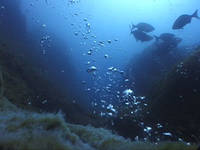
The position indicated by the GPS was later confirmed by the ship’s sonar system after several rounds. In effect, at the right spot, rising majestic at 1 km from the abyss, the Joao de Castro presented a sort of plateau, at a depth of 50 meters. It is only 600 x 300 meters on the surface and several peaks rise up from that point, forming the crater of the volcano. One of these was clearly registered by the sonar system at 16 meters deep. At that point, the captain, Nuño Ramos, ordered to cast the diving anchor, consisting of an anchor with a 10 meter chain and a 40 meter line, tied to an orange surface marker buoy whose purpose is to mark the maximum elevation point and provide divers with a point of submersion and resurface. A reference and support spot in the middle of the ocean. It was difficult to find one’s way in such a “reduced” surface.
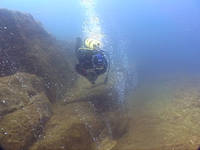 Casting the rubber auxiliary boat was no easy task because of the surf, but a team of six people under directions from Nuño and Bibi made it possible. Meanwhile, the divers got ready for a first recognizance dive, without cameras. Once everything was ready, they went to the diving orange buoy to start diving. Unable to anchor at this depth, the Ranger casted an alternative form of achor; a type of small parachute allowing for better stability and reduce drifting while the ship is standing still.
Casting the rubber auxiliary boat was no easy task because of the surf, but a team of six people under directions from Nuño and Bibi made it possible. Meanwhile, the divers got ready for a first recognizance dive, without cameras. Once everything was ready, they went to the diving orange buoy to start diving. Unable to anchor at this depth, the Ranger casted an alternative form of achor; a type of small parachute allowing for better stability and reduce drifting while the ship is standing still.
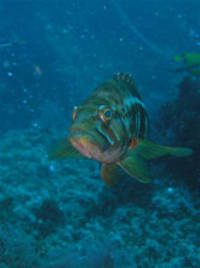
After a long half hour, we saw the divers emerge from the water and speak to Bibi, who waited for them at the dingy: “Bingo! We we found the spot!” The buoy’s anchor had fallen right on the volcano’s peak, which according to Mar and Sole, was in full hydrothermal activity, emitting gases, hot water, and making spectacular burbling sounds. Loud cheers were heard onboard the Ranger.
After a prudent waiting period, to liberate the nitrogen accumulated in their blood during the first dive, he divers changed their oxygen tanks, seized their video and photographic cameras and dove again; and later, a third time.
We have seen the images. Swimming around in a background filled with green, brown and red algae, color altered at times by the sulfide emissions, we see great blactail combers ( Serranus atricauda ), ornate wrasse ( Thalassoma pavo ), rainbow wrasse ( Coris julis ), parrotfish ( sparisoma cretense ) and dolphin fish ( Coriphaena hippurus ). A few meters further, we see a small school of Striped red mullet (Mullus surmuletus), and numerous Bermuda chubs ( Kyphosus sectatrix ) swimming together with bluefin damselfish ( Abudefduf luridus ), among other species still not identified, in addition to Bearded Fireworm ( Hermodice carunculata ) specimens.
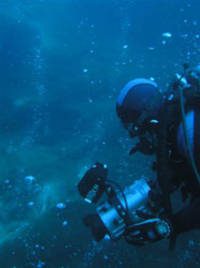
Today we have spent the night standing still, near the buoy. We are considering the possibility to repeat dives to gather more footage and photographs. However, Mar has awakened with some discomfort in one of her ears, experiencing some slight bleeding during the night. Nothing serious, it is just a small blood vessel burst, but it was enough for us to arrive at the decision not to take any risks. We need Mar and Sole in top shape.
This is why we decided to haul up the dinghy, raise the anchor back onboard, and set sails for Lagos, south of Portugal, the next stage of our expedition and the first European continental port the Ranger will visit after its transoceanic crossing. Our arrival at Lagos is expected to occur on June 9th.

